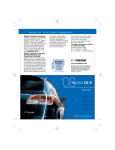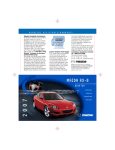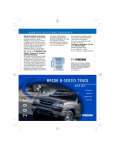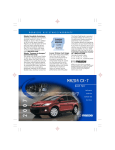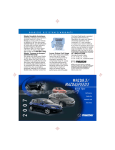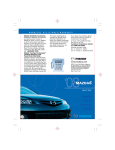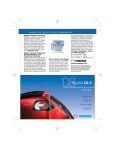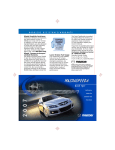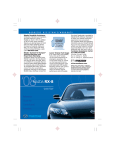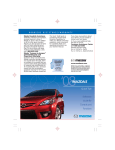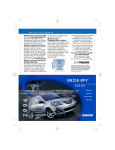Download Mazda 2007 CX-9 Operating instructions
Transcript
ROADSIDE ASSISTANCE/WARRANTY Mazda Roadside Assistance Exhilaration, liberation and inspiration, are great reasons to drive a Mazda car, truck or SUV. In addition to all the other great standard features, you also get peace of mind with our basic warranty period Emergency Roadside Assistance Plan, it’s just a phone call away, 24 hours a day, 365 days a year, call 1-800-866-1998. Mazda ‘’bumper-to-bumper” Limited Warranty We design and build every Mazda to give you driving pleasure now and far down the road. We’re so confident in our quality that we cover the entire vehicle against defects in materials and workmanship for 36 months/36,000 miles, whichever comes first, plus we provide a powertrain warranty for 60 months/ 60,000 miles, whichever comes first. This Quick Tips® guide is provided by Mazda Motor of America, Inc. to make your Mazda ownership experience more convenient. For complete details and operating instructions, see your Owner’s Manual. If you have any questions about your vehicle, you are invited to contact your local dealer. Or if you need additional help, feel free to call our Customer Assistance Center at 1-800-222-5500 Monday through Friday, 8 a.m.- 4:45 p.m., Pacific 9 a.m.- 5:45 p.m., Eastern/Central Unleaded Gasoline 87-octane minimum 20.1-gallon/ 76-liter tank ©2006 Calcar, Quick Tips® is a trademark of Calcar, made in USA 8/06 20.334M DOT ©2006 Mazda Motor of America, Inc. reserves the right to change product specifications at any time without incurring obligations. 9999-95-011C-07QT MAZDA CX-9 Quick Tips ® Reference Guide for 2007 Controls and Functions ® DRIVER’S VIEW 1 2 2 3 4 5 30 6 7 3 2 4 x1000 8 P R N D M 5 6 7 1 F 0 60 40 20 8 8 E 9 TRIP 10 20 15 5 2 2 1 80 mph 100 100 120 80 km/h 140 160 60 180 40 120 200 220 0 5 11 12 13 5 14 140 H 2112 382.3 REAR C MODE ON VOL+ – OFF SET + SET - C H C A/C AUTO MODE H DUAL OFF OUTSIDE PASS FRONT 23 22 27 26 25 24 28 P R N M D REAR CONTROL 17 16 18 19 29 20 18 1. Power window switches, see Mirrors/Windows 2. Door locks, see Locks 3. Mirror controls, see Mirrors/Windows 4. Headlight leveling switch*, see Getting Started 5. Air vents 6. Turn signal/lighting control lever, see Getting Started 7. Audio control switches, see Getting Started 8. Horn/Air bag To beep: Press 9. Cruise control, see Getting Started 10. Wiper/washer control lever, see Getting Started 11. Information display, see Audio Systems REAR 12. 13. 14. 15. 16. 17. 18. 19. 20. 21. 22. 21 Hazard warning switch Push to activate/deactivate Passenger air bag off indicator, see Getting Started NAVI display*, see Owner’s Manual Audio system, see Audio Systems Passenger air bag Climate control panel, see Climate Controls Seat warmer* Press: On/off Accessory socket Cup holders To access cup holders: Press cover down and lift Center console Auxiliary jack Gearshift lever, see Transaxle 23. Storage 24. Tilt/telescopic steering wheel release lever, see Getting Started 25. Power liftgate switch* Press for more than one second or more to fully open/close liftgate 26. Hood release handle Pull release handle to unlock 27. Parking-brake To engage: Push down To release: Push down slightly, then release 28. TCS OFF switch, see Instrument Cluster 29. Fuel-filler lid release To open: Pull lever upward and release 30. HF/TEL Hands-Free Telephone button*, see Getting Started *Denotes optional equipment Always check the Owner’s Manual for more operating information and safety features Driver’s View Getting Started GETTING STARTED MODE VOL+ – 72.0 60 40 20 20 12 2.3 F ER A NG I OFF 80 mph 100 100 120 80 km/h 140 60 160 180 40 120 200 220 0 o PASSE PASS BA G Bluetooth Hands-Free Telephone (HF/TEL)* Before using System consists of Hands-Free 1 Telephone (HF/TEL) button (1) located on steering wheel, information display and microphone; system only functions with a Bluetooth type mobile telephone, a mobile telephone can be programmed only when vehicle is parked 1 OUTSIDE R Getting Started MAZDA CX-9 Quick Tips® are designed to quickly familiarize you with some important features of your MAZDA CX-9 The Driver’s View tab is your index to the Quick Tips®, locate the item you would like to learn more about and then turn to the listed tab This Getting Started section contains important operating tips about your MAZDA CX-9 Items identified in blue text call out important information 140 H C LOAD Passenger air bag deactivation indicator light Front air bag deactivation indicator light (1) provides current status of front passenger air bag and pretensioner system If total seated weight on front passenger seat is less than approximately 66 lb., front passenger air bag deactivation indicator light illuminates, front passenger and side air Hands-Free Telephone setup Pair a phone Quickly press telephone button (1); say “setup” after beep, system prompts you with available options; say “pairing options” after beep, say “pair”, system will ask for a 4-digit PIN of your choice (record PIN number for future phone pairing procedure), slowly say your 4-digit PIN, follow your cellular phone manufacturer’s instructions for placing phone in pairing mode, select Bluetooth on phone, then enter your selected 4-digit PIN on phone’s numeric keypad, system prompts you to name the phone, system will ask for a phone priority number between 1-7, 1 being highest, when programming is complete, system will indicate “pairing complete” bags/pretensioner will not deploy/activate in an accident If the total seated weight is greater than approximately 93 lb., light does not illuminate, and the front passenger and side air bags/pretensioner will deploy/ activate in an appropriate accident See Owner’s Manual for additional information on this feature and the air bag system WARNINGS: Even with a deactivation system, never place rear-facing infant-safety seat in front of any air bag, an infant is in serious danger of being injured or killed If you must install a forwardfacing child-safety seat in the front seating position, move vehicle seat as far back as possible Language Quickly press telephone button (1); say “setup” after beep, say “language” after beep, say “selected language”, you will be asked “is this correct”, say “yes” after the beep, then follow any additional prompts Dialing a phone number Quickly press telephone button (1); say “dial” after beep, slowly say phone number after the prompt, system verifies number is correct, system says “dialing” and then connects your call Redialing last-called number Quickly press telephone button (1); say “redial” after beep, system will redial last dialed phone number See Owner’s Manual for complete operating instructions and warnings *Denotes optional equipment Always check the Owner’s Manual for more operating information and safety features Getting Started Getting Started GETTING STARTED Advanced keyless entry/ start system* Advanced key must be carried by driver to operate properly 5 Refer to Owner’s Manual for additional instructions Tip: Do not use advanced key with activated cell phone in the same pocket, advanced key functions may become disabled Advanced keyless system customization Your authorized Mazda Dealer can customize your system if desired with features such as auto-lock: After exiting the vehicle after driving, the car will automatically lock For additional information on customizable features, see Owner’s Manual Passenger’s door request switch: Press (6) on passenger’s door; all doors and liftgate unlock simultaneously 6 Liftgate request switch: Press (7) on liftgate, doors and liftgate Locking doors will lock/unlock Driver’s/passenger’s door request Advanced key transmitter: switch: Press (6) once on either Press button (2) for driver’s door to lock other doors door; press again within 1 1/2 Press and hold driver’s door request seconds to unlock other doors switch (6) to close windows and and liftgate, hold to lower front moonroof, release to stop windows and open moonroof, Advanced key transmitter: release to stop; with all doors Press button (1); pressing again unlocked, press and hold within a few seconds causes doors button (3) for one second to relock and horn to beep or more to open/close liftgate Unlocking doors/ Activating panic alarm opening liftgate Panic alarm: Press and hold Driver’s door request switch: Press button (4) for more than 1 second; (6) to unlock driver’s door; press horn sounds, hazard warning again within 3 seconds to unlock lights flash; to stop, press other doors and liftgate any remote button Starting engine Press start knob (8); when KEY indicator (green) illuminates on 9 8 9 instrument cluster; turn start knob (8) to START position to start engine Tip: Engine will not start if liftgate is open and advanced key is placed in liftgate/cargo area Auxiliary key operation If advanced key cannot be used due to a malfunction or dead battery, use auxiliary key (5) to lock/unlock doors and to start vehicle To start vehicle: Remove start knob cover (8) by pressing both side release buttons (9) while pulling; insert auxiliary key into key cylinder and turn to start engine Tip: Do not place advanced key on or around dashboard, storage compartments such as glove box or in open liftgate/cargo area, engine may not start or warnings may activate Turning off engine Turn start knob to ACC position to turn engine off, push in and turn start knob to LOCK position Tip: Vehicle battery may be discharged if start knob is left in ACC position Always put vehicle in Park (P), set parking brake and turn start knob to LOCK position when exiting vehicle System operation warnings KEY indicator light flashes (green) indicates advanced key transmitter battery power is low KEY indicator light illuminated continuously (red) indicates system malfunction, and auxiliary key should be used, have vehicle inspected at an Authorized Mazda Dealer as soon as possible 1 2 3 4 LOCK ON S TA RT C AC PUSH 7 *Denotes optional equipment Tip: When using advanced keyless system, system will beep as confirmation of lock/unlock requests, system will also beep if start knob is left in ACC position, advanced key has been left in vehicle or if advanced key is removed from vehicle while vehicle is running For additional system operation warnings, see Owner’s Manual Replacing battery See Owner’s Manual for complete instructions Cautions on use To avoid damage to advanced key, do not allow any severe impacts or contact with liquids, do not place heavy objects on advanced key and do not leave advanced key exposed to direct sunlight or high temperatures, See Owner’s Manual for all cautions and warnings Always check the Owner’s Manual for more operating information and safety features Getting Started Getting Started GETTING STARTED Normal wiper speed: Two clicks down High-speed wiper: Three clicks down Rear window wiper/washer To activate rear interval wiper: Rotate knob (3) up to INT To activate rear normal speed wiper: Rotate knob (3) up to ON To activate rear washer: Rotate knob (3) to and release High beams on/off: Push forward/pull back to detent AUTO* = With ignition switch in ON position; headlights and exterior lights automatically 1 3 turn ON/OFF depending on surrounding darkness/lightness; rotate knob (4) to third notch To flash high beams: Pull back slightly and release 2 3 Turn signals right/left: move lever up/down Wiper/washer lever = Fog lights* on: Rotate (5); Single wipe: Push lever up functions only with low beams on Washer: Pull back, also operates wipers Tips: Beep sounds when 4 5 Intermittent wiper: One click down, to headlights are left on, ignition Turn signal/lighting lever change interval speed rotate ring (1) off, this is a normal condition OFF = Lights off Headlights switch off Auto*: One click down, rain sensor = Tail, parking and dashboard automatically within 30 seconds senses rain amount on windshield, lights on: Rotate knob (4) to first notch (in a few seconds with AUTO* then controls wiper automatically selected) if lights are left = Tail, parking, dashboard Rain sensor sensitivity is adjusted on and switch is in lock and headlights on: Rotate knob from high sensitivity (+) to less position or key removed (4) to second notch sensitivity (-) by rotating ring (2) REAR AUTO REAR AUTO Cruise control Operates above 19 mph Pull up/press down ON/OFF switch (1) to enable/disable To set speed: Press switch (2) down and release To increase set speed: Press switch (2) up and release at desired speed To decrease set speed: Press switch (2) down and release at desired speed To cancel: Press down ON/Off switch (1), tap brake or press CANCEL switch (3) To resume cruising speed: Press switch (4); resume function will not operate if cruise control was cancelled using ON/OFF switch 1 3 42 ON OFF SET + SET - Steeringwheel audio controls To increase/ decrease volume: Pull up/press down (5) Press (6) to either mute standard Audio system or activate Navigation Voice Command* Press (7) to select AM, FM 1, FM 2, CD, RSES* and AUX mode if external device is connected to auxiliary jack Radio: Pull up/press down / (8) less than one second to select next/previous preset station, pull up/press down / (8) for two seconds until beep sound is heard to seek next/previous station CD: Pull up/press down (8) to select next track, pull up/press down (8) to repeat current track 5 6 78 MODE VOL+ – Tilt/ telescopic steeringwheel lever Pull lever (9) down to unlock column; adjust tilt angle/ column length; pull 9 up to lock column WARNING: Do not adjust steering-wheel while driving because you may lose control of the vehicle HID headlights leveling switch* Set position at 0 unless 1 0 vehicle is loaded heavily, leveling switch adjusts headlight angle to compensate for weight of passengers and cargo, see Owner’s Manual *Denotes optional equipment Always check the Owner’s Manual for more operating information and safety features Getting Started Instrument Cluster INSTRUMENT CLUSTER GAUGES 1 1. Instrument cluster dimmer select knob With headlights ON: Rotate knob to increase/decrease brightness Headlights/parking lights ON, ignition key ON: Illumination changes brightness when knob is pressed 2. Tachometer 3. Gear position indicator Displays current gear position or manual mode 4. Gear indicator Displays current gear when in D or M 5. Speedometer 6. Odometer/Trip meter selector Press to view odometer, trip meter A and B; press and hold to reset trip meter A/B settings 2 34 AT P 4 3 x1000r/min 5 2 KEY 7 0 40 20 8 8 E 60 R N D M 6 1 F 5 TRIP 9 80 mph 100 100 120 80 km/h 140 60 160 180 40 20 120 200 220 0 140 H CRUISE 2112 382.3 4WD 8 7. Engine coolant temperature gauge Stop car if above normal range, turn off engine, let vehicle cool; check coolant level when safe 6 C 7 8. Odometer/Trip meter 9. Fuel gauge 20.1-gallon/76-liter tank *Denotes optional equipment WARNING LIGHTS • Cruise control on Amber light: Cruise control system activated; Green light: Cruising speed set; see Getting Started • Tire Pressure Monitoring System (TPMS)*, see Driving Tips • High beams on • Engine oil-pressure Stop car when safe and turn off engine; check oil level • • • • • • CRUISE Brake system Parking brake on/low brake fluid Always fasten seat belts Security indicator light* O Low fuel Door ajar Check fuel cap Fuel cap not securely tightened • Check engine Dealer inspection required if light remains on, see Owner’s Manual • Charging system Charging system malfunction; dealer inspection required • Air bag/front seat belt pretensioner system If light flashes or stays on, the air bags/front seat belt pretensioners may not operate in an accident; dealer inspection required • AT Automatic transaxle* Automatic transaxle malfunction; dealer inspection required • Anti-lock Brake System (ABS) ABS malfunction, normal brakes only; dealer inspection required • KEY*, see Getting Started • TCS OFF Traction Control System is deactivated • Lights ON indicator light* • Traction Control System (TCS)/Dynamic Stability Control (DSC)/ Roll Stability Control (RSC) Light flashes when system is activated while driving; dealer inspection required if light remains on • 4WD AWD warning light* Flashing lamp indicates high temperature differential oil, illuminated lamp indicates an abnormality with AWD system; dealer inspection required • Wrench light Dealer inspection required if light remains on, see Owner’s Manual Always check the Owner’s Manual for more operating information and safety features Instrument Cluster Locks LOCKS Auxiliary key* See Getting Started Keyless entry system Functions only 2 with ignition in 3 OFF position 4 To lock doors: Press button (2); pressing again within a few seconds causes doors to relock and horn to beep To unlock: Press button (3) for driver’s door; press again within 3 seconds to unlock other doors and liftgate, press and hold to lower driver's and passenger windows and open moonroof, release to stop Panic alarm: Press and hold button (4) for more than 1 second; horn sounds, hazard warning lights flash; to stop, press any remote button Manual door locks To lock: Press front of button (1) toward door handle 2 To unlock: Pull front of button away 1 from door handle Power door locks To lock/unlock all doors and liftgate: Press bottom/top of switch (2) Using key to lock all doors: Rotate key to clockwise position, continue to hold key in lock position to roll front windows up and close moonroof, release to stop Using key to unlock driver’s front door: Rotate key to counterclockwise position for more than one second to unlock other doors and liftgate, continue to hold key in unlock position to roll front windows down and open moonroof Liftgate To open: Pull 3 4 up on handle (3) and raise; to close: Push liftgate down with both hands until in near-shut position, easy closure system will close liftgate completely Liftgate request switch Liftgate request switch* (4) operation, see Getting Started Power liftgate close switch Press (5) for one second or 5 more; hazard warning lights flash twice; liftgate closes automatically after beep sound is heard 1 Key Operates ignition and all locks Tips: Use key number plate to purchase a new key; store in safe place separate from vehicle Only advanced keyless system automatically locks doors when leaving with key (dealer programmable feature) Retractable type key To fold/unfold press button (1) Advanced keyless entry/ start system/ auxiliary key* See Getting Started Illuminated entry system Activates interior lights when dome light switch set to DOOR position; lights off after driver’s door is locked or ignition in ON position Immobilizer system Prevents engine from running unless coded key is used, see Owner’s Manual WARNING: Never leave a child alone in vehicle and never leave any key where a child can find it, particularly advanced keys which give easier access to a curious child WARNING: Never place hands or fingers around liftgate because liftgate closes automatically from near-shut position, this could cause hands and fingers to be pinched and injured Child-safety locks Located at edge 6 of rear doors To activate: Pull tab (6) up; door opens from outside only To cancel: Push tab (6) down WARNING: Since children may access either rear door, child-safety locks for both rear doors should be activated *Denotes optional equipment Always check the Owner’s Manual for more operating information and safety features Locks Mirrors/ Windows MIRRORS/WINDOWS 1 L R 2 3 AUTO AUTO 4 5 Dual power mirrors Ignition switch must be in ACC or ON position To adjust left/right mirror: Press selector (1) left/right, press (2) in direction of desired movement Tip: To lock mirrors in place, move switch (1) to center position 3 8 7 Power window switches With ignition ON All windows controlled from driver’s armrest; passenger doors have separate switches Front window switches One-touch down/up: Press/pull AUTO switch (3) firmly and release, window goes down/up all the way, press/pull briefly to stop, press/pull lightly and hold for normal operation, momentarily press front power window switches, front windows will open to vent position Tip: During closing front window operation, front window will stop and open partway if object blocks window operation Power window lockout switch Press button (5), only driver's window operates; press again for normal operation 3 OFF 9 2 OFF DOOR Rear window control switches Push/pull (4) to open/close Power window initialization procedure If battery is disconnected or power window fuse is replaced, the auto open/close and anti-pinch features will not function until initialization is complete Initialization procedure: 1. Turn ignition switch to “ON” position 2. Press front passenger power window switch down to fully open window, then pull switch up to close window completely, continue holding switch up for at least 3 seconds, then release switch 3. Move to driver’s door and repeat Step 2 for driver’s window 4. After windows have been initialized turn ignition to “LOCK”, then back to“ON” ON OFF DOOR ON 1 2 6 1 5 1. Map/reading light switch Press on/off 2. Interior light switch DOOR = light on when door open ON = light always on OFF = light always off Tip: All interior lights can be turned ON/OFF using driver’s overhead switch when all light switches are in DOOR position 3. Front interior light 4 4. Rear interior light 5. Hands-Free Telephone/ navigation microphone* 6. Storage/sunglasses holder 7. Moonroof tilt switch* One-touch operation: Tilt open/close, push/pull down switch 8. Moonroof slide switch* One-touch operation: Slide open/close, press rear/front of switch Tip: With all doors closed, moonroof and front windows can be opened via Keyless entry by pressing and holding unlock button, or opened/ closed by turning and holding driver’s door key toward front/rear of vehicle 9. Cargo light DOOR = Light on with any door or liftgate open OFF = Light always off *Denotes optional equipment Always check the Owner’s Manual for more operating information and safety features Interior Lights Seats SEATS Manual seat 1. Fore-aft adjustment Lift lever and hold, slide seat, release lever 2. Raise/lower seat (Driver’s seat only) Pull/push lever and release 3. Seat back angle To adjust: Lift and hold lever, lean forward or backward to tilt seat, release lever 4. Manual lumbar adjustment (Driver’s seat only) Pull lever forward repeatedly for more support 5. Head restraint To raise/lower: Pull up/hold release button (11) and push down Power seat* 6. Seatback angle Press front/rear of switch 7. Power lumbar adjustment* Press front/rear of switch to increase/decrease lumbar support WARNINGS: Do not adjust seats while driving Safety belts must always be worn when vehicle is in motion Air bags are supplemental and do not replace safety belt usage Always wear your safety belt and properly secure children 12 and under in the rear seat Even with a deactivation system, never place rear-facing infant-safety seat in front of any air bag, an infant is in serious danger of being injured or killed If you must install a forwardfacing child-safety seat in the front seating position, move vehicle seat as far back as possible 5 11 4 5 1 2 11 3 7 6 8. Raise/lower front of seat Pull/push front of switch vertically Fore/aft adjustment Slide switch horizontally Raise/lower rear of seat Pull/push rear of switch vertically Raise/lower seat Pull/push center of switch vertically Seat position memory* Adjust seat, then press and hold set button (9), then select and press a memory position button (10) to save setting Tip: To program memory seat into advanced key*/retractable key, with ignition off; key removed and driver’s door open, press and hold set button (9) while holding unlock button on transmitter until beep is heard 8 9 10 Shoulder belt height 1 adjustment To raise: Push adjuster up To lower: Pull button (1), slide down; release button WARNING: Make sure adjuster locks in one of its positions Child-safety seat To install in rear outboard seats: Use dual locking mode retractor seat belts; see Owner’s Manual for proper installation and child seat tether and LATCH system instructions WARNING: Use age appropriate child restraints, see Owner’s Manual and state or province laws Safety belt emergency locking mode Belts lock only on hard acceleration, braking, cornering or impacts of about 5 mph or more Automatic locking mode (front passenger and all rear safety belts only) Must be used when installing child-safety seat To activate: Pull webbing fully out of retractor, allow belt to retract until click is heard; belt will only tighten To disengage: Unbuckle belt and allow webbing to retract fully *Denotes optional equipment Always check the Owner’s Manual for more operating information and safety features Seats Rear Seats REAR SEATS Rear center position seat belt† To pull seat belt from ceiling recess (1): Slide tongues with finger while moving downward Fastening seat belt: Tongue (2) and anchor (3) must be fastened, then slowly pull out lap/shoulder belt (4), put belt through loop (5) 1 5 4 6 7 2 3 1 1 3 2 2 Folding second-row seats Pull lever (1) up and lower seatback; when raising, lock into upright position P R N M D Automatic Transaxle Gearshift must be in Park or Neutral to start engine; it must be in Park to remove ignition key P = Park To move gearshift from Park: Press firmly on brake pedal then move the shift lever out of P R = Reverse N = Neutral No gear engaged D Drive (Overdrive) For normal driving: Shifts through all forward gears automatically Seat slide Moving seat forward/backward, raise bar (2) and slide seat to desired position; release bar Seatback angle Pull up lever (1), then lean back to desired position; release lever Third-row seat access Pull lever (3) and tilt seatback and slide seat forward M (Sport A/T manual shift mode) Move shifter from N D to M to engage M D manual shift mode, M will be illuminated for manual mode on shift position indicator located in the instrument panel Manual shifting of transmission is achieved by moving shifter back to upshift and forward to downshift, move shifter from M to D to engage automatic shift mode P R and insert tongue (6) into buckle (7) until click is heard Unfastening seat belt: Depress buckle button to release Stowing seat belt: Retract belt, put tongues (2) and (6) together, insert securely into recess (1) 4 4 Folding third-row seats Grip strap (4) and pull to fold seatback down Gear indicator Illuminated numeral of gear indicator located in the instrument panel displays current gear in Automatic and Manual shift modes Tips: Back-up camera** automatically operates when gearshift lever is placed into reverse and is viewable via navigation display screen When using back-up camera, objects may be closer than they appear, please check your surroundings P R N D M *Denotes optional equipment **Back-up camera feature is only available with optional Technology Package † See Owner’s Manual Always check the Owner’s Manual for more operating information and safety features Transaxle Climate Controls CLIMATE CONTROLS 1 1. Air flow selections 2 3 4 5 13 6 2 7 = air to dash = air to dash and floor C = air to floor C H H A/C AUTO DUAL MODE OFF OUTSIDE = air to floor and windshield PASS = air to windshield (defrost) 2. Temperature control driver/passenger Cooler/warmer = rotate knob counterclockwise/clockwise 3. A/C = air conditioner Press to turn on/off 4. OFF Press to turn system OFF 5. Fan control Rotate knob clockwise/ counterclockwise to increase/ decrease fan speed FRONT REAR L MAX OFF 16 15 C H REAR CONTROL 12 11 10 10 9 8 Automatic operation 8. Air intake control Press AUTO (13) for automatic Press switch to alternate between recirculated (Indicator operation; rotate outer dial to set temperature, refer to information light on) or outside (Indicator display for air flow selection, see light off) air mode Owner's Manual = recirculate inside air; use for maximum cooling Tip: Automatic climate control WARNING: Do not use display viewed via information position in cold display, see Audio Systems weather, windows may fog and hamper vision 6. Outside 9. Rear control Press Outside button (6) to display 10. Seat warmer* outside temperature, press again Press on/off to switch display to temperature 11. Rear window set for air conditioner defogger Tip: To change from Press on/off; shuts off with Fahrenheit to Centigrade ignition or automatically after or vice versa: Press and 15 minutes of operation; also hold Outside button (6) operates heated outside mirrors* for 3 seconds or more 12. Windshield defroster 7. Dual switch Press (7) to switch between Press: Fresh air position is dual (driver/passenger) automatically selected, A/C or individual temperature automatically turns ON operation modes 14 R Rear climate control Turn air conditioning (3) on; press rear control button (9), indicator light on, rear passengers can now control fan speed (14) and rear temperature (15) Control positions for maximum defrost Fan to maximum, temperature to maximum hot, selected Tip: To help prevent windshield fogging in humid weather, select before starting engine To prevent moisture buildup, never drive with system off Objects placed under the front seats may interfere with air flow to the rear Control On indicator (16) is illuminated when rear climate control is active *Denotes optional equipment Always check the Owner’s Manual for more operating information and safety features Climate Controls Audio Systems AM/FM STEREO/CD/CD CHANGER 1. Power/Volume 72.0 10:30 72.0 19 Press to turn on/off; rotate to increase/decrease volume 6 8 7 20 9 10 2 15 14 2. Random LOAD Press to play CD selections RPT SCAN 1 RDM 2 3 DISC in random order, press again FM/AM 16 5 to cancel CLK SET 4 5 6 DISC 3. Auto-Memory SAT CD Press and hold until a beep sound is heard; system automatically MEDIA scans and temporarily stores six strong stations in each band; press again to switch to another 4 3 A B 12 1 13 11 18 17 preset station DISP 7. Scan 18. Reverse /Fast forward CD: Press repeatedly to scroll Radio: Press to sample Press to reverse/fast forward through displays strong stations, press again through a track Text*: Rotate right/left to display to stop at current station 19. Information display titles longer than 12 characters CD: Press to play first few seconds Has the following functions: Clock, 4. Tune of each selection, press again audio display, automatic climate Radio: Rotate counter to stop at current selection control display and outside clockwise/clockwise for lower/ 8. RPT temperature display higher frequency Press to replay current CD selection AUTO A/C o DUAL DISC IN 1 2 3 4 5 6 MD IN ST OUTSIDE AF PTY RPT RDM TA TP AUTO-M PASS o F F TRACK SEEK VOLUME UDIO CO PU S HA NT TO AU USH AU OP DI R PUSH POWE TEXT 5. SEEK/TRACK Radio: Press / to automatically seek higher/ lower frequency CD: Press / to select next track/beginning of current track 6. LOAD* To load multiple discs: Press and hold LOAD (6) until beep sound is heard; insert CD when “IN” is indicated on information display (19) To eject disc: Press Eject (14) To eject specific disc: Press and hold Eject (14) until beep sound is heard; within five seconds press the desired tray number 1-6 (15) *Denotes optional equipment **See Navigation Owner’s Manual for clock setting procedure if equipped with Navigation System 9. FM/AM Press to turn radio on and select between FM1/FM2/AM station preset buttons (15) 10. CD slot 11. SAT*, Satellite ready capability 12. CD, Press to play CD 13. Media (AUX) Select external digital devices 14. CD eject button 15. Memory preset buttons To set: Tune to station, press and hold until beep sound is heard 16. Disc / * Press to skip to next/previous CD 17. Audio control Audio: Press to select ALC/BASS/ TREB/FADE/BAL/BEEP/Surround* OFF/1/2/3, rotate right/left to adjust selected feature Tip: Automatic Level Control (ALC) automatically adjusts audio volume depending on vehicle speed Clock** To set: With ignition in ACC or ON position, press (A) and hold until beep sounds; 12hr/24hr will appear on display (20); press (B) to select; press (A) again while selection is flashing: Hr ADJUST displays; press (B) to select hour; press (A) when done, do the same to set minutes Navigation/Audio system* AudioPilot* (BOSE system) Automatically adjusts audio volume in accordance with level of noise entering vehicle; press on-screen button to turn ON/OFF Centerpoint* (BOSE system) Delivers multi-channel surround sound while listening to CDs See Owner's Manual for complete details Rear entertainment system* See Owner’s Manual Always check the Owner’s Manual for more operating information and safety features Audio Systems Cargo Area CARGO AREA 4 61 2 7 53 8 Spare tire 1. Temporary spare tire Stored under vehicle; to change flat tire: Follow instructions in Owner’s Manual WARNING: Do not exceed 50 mph with temporary spare Tip: For instructions and restrictions on use of temporary spare tire, see Owner’s Manual 2. Jack 3. Lug wrench and jack lever 4. Spare tire jack screw socket 5. Spare tire jack screw 6. Spare tire hold down strap 7. Tiedown eyelet 8. Navigation DVD player*† 11. Rear accessory socket Cargo area 12. Rear auxiliary terminals* 9. Cargo securing loops 13. Power outlet (AC 115V)* 10. Cargo floor Cargo light Tip: Cargo floor cover can be secured in raised position Located on interior side of liftgate See Interior Lights for operation by attaching third-row straps (14) to underside of floor cover 13 9 12 *Denotes optional equipment † See Owner’s Manual 10 14 9 11 Gas cap After filling vehicle with gasoline, fully reinstall gas cap by turning clockwise until a clicking sound is heard, if gas cap is not fully installed, Check Engine light and/or gas cap indicator light may come on For more information on Check Engine light, see Owner’s Manual Tire economy and tips Check tire pressure monthly when tires are cold, use a digital tire pressure gauge for accurate tire pressure measurement Tires should be of the same type and size Maintain correct front-end alignment and tire balance; rotate tires at 5,000 or 7,500 mile intervals; see Owner’s Manual for rotation chart Tire pressure Decal on Driver’s B-pillar provides tire pressure information Tire Pressure Monitoring System (TPMS) Warning light illuminates for a few seconds after ignition is on If tire pressure is too low in one or more tires, warning light will illuminate and beeper will sound; flashing warning light indicates possible malfunction; dealer inspection required Anti-lock Braking System (ABS) ABS automatically reduces hydraulic pressure to any wheel on the verge of locking up You may feel a slight pulsing of the brake pedal and hear a clicking noise; this tells you the ABS is functioning properly; increase pressure on pedal for maximum braking Tips: Maintain constant pressure on the brake pedal Do not pump the brakes ABS self test A self-diagnostic test is performed when starting; you may feel some brake pedal pulsation and hear some noise, this is normal Traction Control System (TCS) Enhances traction and safety by regulating engine torque When TCS detects drive wheel slippage it lowers engine torque to prevent loss of traction Dynamic Stability Control (DSC) Controls braking and engine torque in conjunction with ABS and TCS to help control side slip on slippery surfaces or during sudden or evasive maneuvering Roll Stability Control (RSC) System determines when corrective action is needed; by controlling engine torque and braking on each wheel Always check the Owner’s Manual for more operating information and safety features Driving Tips Under Hood UNDER HOOD 2 1 11 6 4 9 10 8 12 3 7 5 3.5-liter Engine 1. Engine coolant reservoir Level should be between COLD FILL RANGE indicator marks WARNING: Never remove coolant reservoir cap while engine is running or hot; remove only when system is cool 2. Power steering fluid reservoir Level should be between MIN and MAX lines 3. Automatic transaxle fluid level dipstick Fluid Hot scale A Fluid above 150oF, level must be between full and low Fluid Hot scale B Cold fluid below 70oF should be close to, but not above bottom notch on dipstick 4. Battery Break-in period First 600 miles: Avoid heavy braking and acceleration; drive at varying road and engine speeds; engine should not exceed 3500 rpm in Park or Neutral Tip: Follow the same procedures with newly overhauled engine or when brakes are replaced Maintenance notes: Rotate tires every 7,500 miles or sooner if needed Replace cabin air filter every 25,000 miles or 24 months Replace spark plugs every 100,000 miles Inspect drive belts every 105,000 miles; replace every 150,000 miles Replace (FL22) engine coolant at 120,000 miles WARNING: Using coolant other than FL22 requires more frequent maintenance intervals NORMAL SERVICE INTERVALS 7,500 miles A 15,000 miles A 22,500 miles A 30,000 miles A B 37,500 miles A 45,000 miles A 52,500 miles A 60,000 miles A B 67,500 miles A 75,000 miles A 82,500 miles A 90,000 miles A B F E F C FG D E F C F E FG Tip: For additional service intervals and complete details, see Owner’s Manual *Denotes optional equipment † See Owner’s Manual 5. Air filter 6. Brake fluid reservoir Fill to MAX mark with DOT 3 fluid; check with cap on 7. Fuse block panel Push latch in; lift cover 8. Hood latch Pull up to release hood 9. Engine oil dipstick Fluid should be between max. and min. on dipstick; do not fill above max. 10. Engine oil filler cap SAE 5W-20 11. Windshield washer fluid reservoir Fill with windshield washer fluid 12. Hood support rod Tip: Check all fluids with vehicle parked on a level surface and engine off unless otherwise stated A. Replace: Engine oil and filter† Lubricate: All locks and hinges B . Inspect: Fuel lines and hoses, brake lines, hoses and connections, steering operation and linkages, front and rear suspension and ball joints, drive-shaft dust boots C . Replace: Air filter D. Inspect: Hoses and tubes for emission system Replace: Engine coolant (Other than FL22) E . Tighten: Bolts and nuts on chassis and body F . Inspect: Disc brakes G. Inspect: Exhaust system and heat shields Tip: For severe driving conditions, Owner’s Manual recommends changing oil and filter at 5,000† miles Always check the Owner’s Manual for more operating information and safety features














